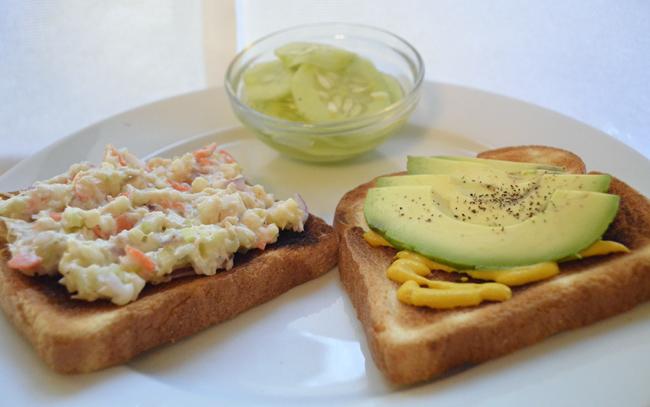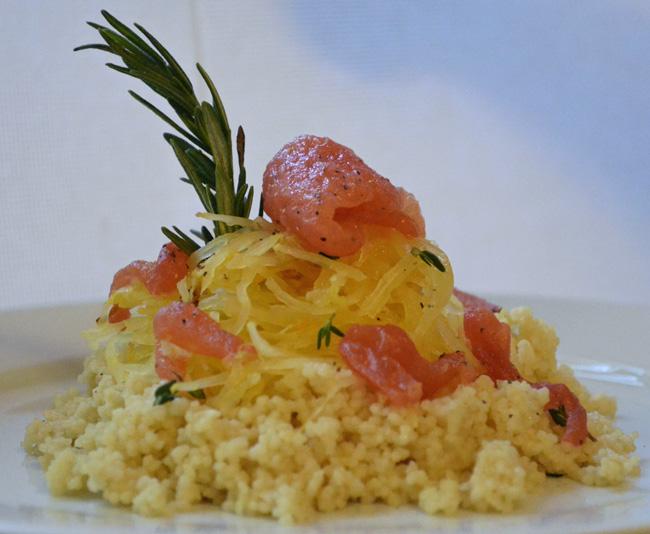Eating right doesn’t have to mean sacrificing your time, health or paycheck to avoid breaking your New Year’s resolutions. Estimates show that of the 45 percent of Americans who typically make a resolution, only 8 percent ever achieve their New Year’s goals. On Jan. 1, results of a poll on the most common resolutions for 2014 were released by the University of Scranton’s Journal of Clinical Psychology. The poll ranked “losing weight” and “staying fit and healthy” as No. 1 and No. 5, respectively. In many cases, moderation – not abstention – is key in achieving healthy eating goals and overcoming culinary indulgences.
“Don’t get discouraged with your New Year’s resolutions to the point where it dramatically affects your daily routine,” says Dr. Claudia Fajardo-Lira, CSUN food science professor and nutritionist. “Instead, make small efforts to improve your eating habits rather than drastic changes.”
Fajardo-Lira recommends cutting your sugary beverage — like sodas, high fructose juices, energy drinks — consumption in half. Instead of ordering a flavored latte, opt for a regular cup of coffee with a little sweetener.
“Incorporate more protein into your breakfast, such as yogurt with granola or fruit, or a serving of string cheese,” says Fajardo-Lira.
If you find yourself weighing the pros and cons of splurging on an alcoholic drink after a stressful day, Fajardo-Lira suggests choosing a light beer. Alcohol is full of empty calories and takes the place of other nutrients the body relies on. Although light beer is no more nutritious than a regular beer, it does have fewer calories.
Choose foods that are low in saturated fats and avoid sugary snacks. When converting food into energy, the body produces insulin, which affects blood sugar levels. The body will store any excess metabolized calories as fat cells, turning your potential six-pack into a beer belly. Eating between meals is OK, but choosing the correct foods can be difficult. When rummaging the cupboards for a mid-day snack, think of your decision in terms of an extended release aspirin: the higher the nutrient density, the longer it will take the body to digest.
Here, the Sundial’s chef-in-residence shares some recipes of his own to help you eat better in 2014.
For lunch:

Albacore Tuna Salad Sandwich
· 10 ounces canned Albacore tuna (low sodium, in water)
· 1 medium carrot, peeled
· 1 piece of celery, diced
· ¼ red onion, thinly sliced
· ½ green apple
· 2 tablespoons low fat mayonnaise
· 1 teaspoon kosher salt OR ¾ teaspoon garlic salt
· 1 teaspoon black pepper
· 1 avocado, halved and sliced
· Condiments optional
· Lightly toasted whole-grain bread, such as Nature’s Own Honey 7 Grain bread
Makes 4 sandwiches at 350 calories per serving (based on ingredients), 3-5 day shelf life
Instructions:
1. Drain the liquid from canned tuna and place tuna into a mixing bowl.
2. Use a peeler to skin the carrot and slice into thin ribbons. Finely chop the ribbons and add to the mixing bowl.
3. Clean celery and cut into lengthwise strips. Finely dice and add to mixing bowl.
4. Core and remove skin from apple and finely dice. Add to mixing bowl.
5. Peel onion and cut in half hemi-spherically, leaving the root of the onion intact. Thinly slice onion lengthwise and add to mixing bowl.
6. Add mayo, salt and pepper to mixing bowl and stir ingredients until evenly mixed.
7. Spread mixture and sliced avocado on to bread to complete sandwich.
Prep time: 10 minutes
Pickled Cucumbers
· 1 English (Hot House) cucumber
· 4 fluid ounces rice wine vinegar or white vinegar
· 2 tablespoons granulated sugar
· 1 tablespoon kosher salt
· 1 teaspoon black pepper
Makes 2 servings at 50 calories per serving, 4-5 day shelf life
Instructions:
1. Clean and peel cucumber, then remove the ends. Slice the cucumber into ¼ inch discs and place inside a sealable container.
2. Add vinegar, sugar, salt and pepper to container, fully submerging cucumbers in liquid.
3. Let cucumber marinate for one hour before eating.
Prep time: 1 hour 10 minutes
Dinner:

Baked Chicken Breast and Rosemary Asparagus
· 6 ounce chicken breast (frozen or fresh, skinless)
· 4 ounces asparagus, trimmed
· 1 lemon, halved
· 1 sprig fresh rosemary or 1 teaspoon dried
· 1 bunch fresh thyme (not dried)
· 4 cloves garlic, smashed
· 8 fluid ounces olive oil (vegetable or sunflower oil works too)
· 1 tablespoon kosher salt
· 1 tablespoon black pepper
· 1 teaspoon unsalted butter
Makes 1 serving at 550 calories per serving, 4-5 day shelf life
Instructions:
1. If necessary, defrost chicken overnight in the fridge in a sealed container. Once thawed, rinse under cool, running water and pat dry.
2. Puncture chicken with a fork or sharp knife and place into a sealable container with 6 fluid ounces of oil, 3 garlic cloves, lemon and all of thyme. Shake and refrigerate.
3. Marinate chicken for at least 8 hours, 24 hours is best.
4. When you’re ready to cook the chicken, bring a small pot of lightly-salted water to a boil.
5. Wash asparagus and trim ends. Boil asparagus for 2-3 minutes and set aside to cool.
6. In a medium skillet, add 1 fluid ounce oil, garlic and butter. Season the chicken with salt and pepper and cook 4 minutes on each side. Cover, reduce heat to low and cook for 8 minutes.
7. In a separate cooking pan, bring the remainder of the oil to medium heat. Finely chop the rosemary and set aside.
8. Once the oil is hot, toss in the asparagus and rosemary and cook for 3-4 minutes. Remove asparagus from pan and drain excess oil.
9. Check to make sure the chicken is cooked thoroughly and serve with asparagus.
10. You may also add 3-4 ounces of any starch, such as brown rice.
Prep Time: 1 day
Cook Time: 30-45 minutes

Spaghetti Squash “Pasta” and Roasted Tomato Couscous
· 1 spaghetti squash
· 4 tomatoes (ripened on the vine are best)
· 4 ounces couscous
· 1 cup vegetable stock
· 1 bunch fresh thyme
· 6 cloves garlic
· 2 tablespoons unsalted butter
· 2 tablespoons olive oil
Makes 2 servings at 650 calories per serving
Instructions:
1. Line a baking sheet with wax paper or aluminum foil and preheat oven to 425 degrees.
2. Using a large knife, carefully cut the spaghetti squash in half and remove the seeds with a spoon. Place squash rind side facing up on baking sheet and cook for 34-35 minutes.
3. After the squash is cooked and allowed to cool, separate the squash from its rind with a fork in a scraping motion. The squash should resemble spaghetti.
4. Remove stems from tomatoes and slice in half, then remove the seeds. Toss tomatoes in oil and place skin side up onto baking sheet. Season with salt and pepper.
5. Roast tomatoes for 8-10 minutes with some fresh thyme and four garlic cloves. Finely chop the two remaining garlic cloves and set aside. Allow tomatoes to cool once cooked.
6. In a medium saucepan add butter and garlic. When the garlic begins to brown, add the couscous and lightly toast the grain until the butter has been absorbed.
7. Add half the vegetable stock and stir, allowing the couscous to absorb the liquid. Add rest of the vegetable stock and a few sprigs of thyme, and reduce to low heat.
8. Cut the roasted tomatoes into small slivers and add to couscous. Cover mixture and cook until the vegetable stock has been completely absorbed. Do not stir.
9. Plate the couscous in the center of the plate with a small “well” to add the prepared spaghetti squash.
10. You may also throw in some other vegetables to roast with the tomatoes.
Prep Time: 15 minutes
Cook Time: 1 hour





